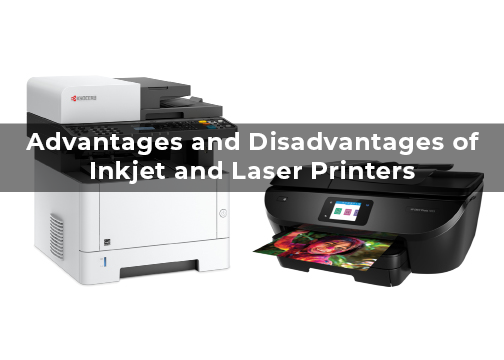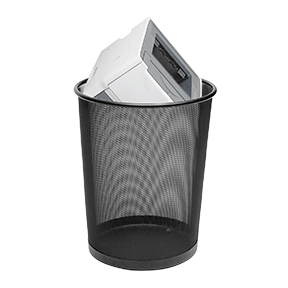
MANAGED PRINT SERVICES | 5 MIN READ
If you're looking for the pros and cons of inkjet and laser printers, you've come to the right place! Despite society's move to greener printing options that often require less paper use, the fact remains: printing is still a major part of most businesses.
Whether it's mass printing statements or invoices, mailers, proposals, or something else, nearly all businesses need a way to print. The question, then, is what kind of printer is best?
This article will break down the advantages and disadvantages of inkjet and laser printers so that you can be better informed when you decide to make a purchase.
As a supplier of office technology for over 50 years, our company has bear witness to the many evolving needs of the workplace as each decade passes.
Printers no longer just print.
Depending on the unit you purchase, you can scan, email, fax, and more. What was once sacred to copiers is no more - although copiers have truly become multifunction printers in their own right. But what about the most important function - printing?
Advantages of Inkjet Printers
Most of the advantages with inkjet printers are associated with their cheaper upfront costs. Inkjet printer hardware (the actual machine) can be very cheap, so, if cash on-hand is an issue for you, it's possible to get several inkjet printers for the price of a laser printer. But there is a trade-off for this bargain, which I will address later. Online, it's possible to purchase an inkjet desktop printer for less than $10!
What? That seems too cheap!
Well, the saying, "sometimes you get what you pay for," is a saying for a reason. This can certainly be the case with printers.
The second advantage to purchasing an inkjet printer is its extremely easy setup process. For most, simply pull it out of the box, attach the power cord, and you're off!
Advantages of Laser Printers
 People usually associate laser printers with higher quality, faster speeds, and better reliability. There's a reason for that.
People usually associate laser printers with higher quality, faster speeds, and better reliability. There's a reason for that.
Laser printers are toner based units that use laser technology to melt toner dust onto your prints (which is why they always come out warm). The result is a very clean look that doesn't bleed when it gets wet.
Per page volume is nearly always cheaper than its inkjet counterpart, with owner's of laser printers seeing the most savings over the course of the life of the printer.
For business, laser printers can be managed through managed print services. This can create significant savings if a business has any real volume (or a large number of units), because a dealer has greater buying power to be able to supply your company with toner refills at a significantly reduced price.
READ: What Are Managed Print Services?
Depending on the type of laser printer you own, you can save even more on the costs of toner replenishment if you use a system that has the option of directly refilling the printer with toner (as opposed to throwing away an entire cartridge and replacing it).
Kyocera revolutionized this process with their ECOSYS line of printers, named after the printer's more environmental approach to toner refills.
READ: Kyocera Printers vs HP: Costs, Comparisons and Considerations
Disadvantages of Inkjet Printers
You may notice a trend when you read about the disadvantages of both inkjet and laser printers. Mainly, this is because they are almost opposites of the other's advantages.
With inkjet printing, where you save a tremendous amount on upfront costs (i.e. price of the unit), you often spend a tremendous amount on ink refills. If you're a business, you most likely won't have time to make a special trip to a big box retailer to get cartridge refills every week. More likely, you'll stock up and spend $30-$40 per cartridge to have them delivered to you for when you run out.
The irony of the $10 printer listed earlier? The cartridge is worth more than the printer. Can you believe that, in some cases, it's actually more cost effective to throw away your old printer and purchase a new one each time you run out of ink?
 Sound crazy? Printer manufacturers know that you wouldn't go through that hassle every time (or maybe won't even consider it).
Sound crazy? Printer manufacturers know that you wouldn't go through that hassle every time (or maybe won't even consider it).
They keep their margins extremely low, or non-existent, on their inkjet printers for the bet that they will make it up on cartridge sales.
If you have any kind of volume, it isn't cost effective to go with an inkjet printer. If you print a few documents per month, you might be okay, but this certainly isn't a viable option for 99% of businesses.
If you enjoy helping out the environment, then ink cartridges may not be right for you. Inkjet cartridges have significantly reduced volume, and as a result, throwing away cartridges will become very common.
What about recycling?
This is an option for you, but it must be done at a location that will accept printer cartridges for recycling. Because ink cartridges are considered electronics, you can't simply toss them in your regular recycling bin. Making repeated trips to the store may not be the best use of your time when there are more eco-friendly options out there.
Disadvantages of Laser Printers
Laser printers do have the advantage of cost savings on the back-end but can be much more expensive on the front end. Some desktop laser printers can run over $1,000. They are essentially mini-multifunction printers. As a result, although they look great and work great, these are not cost-effective options for people with low volume (resist the impulse buy for the fancier printer in this case).
Depending on the brand of laser printer you purchase, your recycling options may not be much different than that of an inkjet printer. If you don't have the Kyocera ECOSYS line, you're going to have to recycle your cartridges at a location that accepts electronics, or make your peace with tossing it in the garbage, and ultimately, a landfill.

Other than those two factors, the only other disadvantage of a laser printer is its slightly more complicated set-up. If you have a managed print services provider, this won't be a headache for you, though.
They will do all the setup and maintenance for you as part of a monthly service plan. If you don't have a service provider, setup is as simple as following the directions that come with the printer.
How Do I Choose a Printer?
At the end of the day, the most important thing to consider is your volume. If you have very low volume or a single printer, inkjet may be fine for you. Those cartridges do add up in a hurry, though, so if you think you will have any kind of regular printing, you need to strongly consider a laser printer.
Don't throw your money away simply because you want to save a little at the beginning. The cost difference over the long-haul is significant.
Want to Learn More?
How Much Does A Printer Really Cost?
What Are Managed Print Services?
Kyocera Printer vs HP: Costs, Comparisons, and Considerations
How Much Does A Copier Cost?
Posted by Scott Sinkler

Scott Sinkler is a Standard Office Systems Strategic Account Manager and has been helping businesses with their office technology needs from over 20 years.

